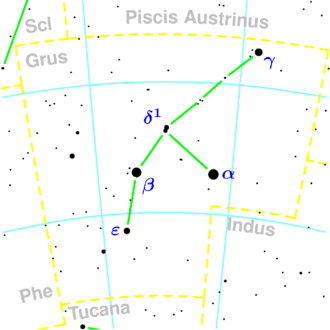Grus-II-Zwerggalaxie
| Galaxie Grus-II-Zwerggalaxie | |
|---|---|
| AladinLite | |
| Sternbild | Kranich |
| Position Äquinoktium: J2000.0, Epoche: J2000.0 | |
| Rektaszension | 22h 04m 04,8s |
| Deklination | -46° 26′ 24,0″ |
| Erscheinungsbild | |
| Morphologischer Typ | dSph |
| Helligkeit (visuell) | (14,72 ± 0,22) mag |
| Physikalische Daten | |
| Zugehörigkeit | Lokale Gruppe |
| Entfernung | (173.000 ± 16.000) Lj / (53.000 ± 5.000) pc |
| Absolute Helligkeit | (−3,9 ± 0,2) mag |
| Geschichte | |
| Entdeckung | Dark Energy Survey |
| Entdeckungsdatum | 2015 |
| Katalogbezeichnungen | |
| Gru II dSph • DES J2204−4626 | |
Die Grus-II-Zwerggalaxie, kurz auch Grus II oder Grus 2, ist eine im Jahr 2015 entdeckte Zwerggalaxie des Typs dSph im Sternbild Kranich in der Lokalen Gruppe und eine der Satellitengalaxien der Milchstraße.[1]
Eigenschaften
Gru II dSph besitzt einen Halblichtradius von ′, was bei einer Entfernung von etwa 53 kpc einer Größe von (93 ± 14) pc entspricht. Sowohl ein deutlicher Roter-Riesen-Ast wie auch einige Mitglieder eines blauen Horizontalasts sind im Farben-Helligkeits-Diagramm erkennbar. Die Entfernung zur Großen Magellanschen Wolke beträgt 46 kpc und zum Zentrum der Milchstraße 49 kpc. Mit 33 kpc liegt sie etwas näher an der Kleinen Magellanschen Wolke und mit nur 18 kpc erstaunlich nahe zu Zwerggalaxien im Tukan. Auch wenn eine aktuelle Wechselwirkung zu diesen derzeit eher auszuschließen ist, kann eine frühere Interaktion mit diesen Systemen nicht ausgeschlossen werden.[1]
Weiteres
- Liste der Galaxien der Lokalen Gruppe
Weblinks
Einzelnachweise
- ↑ a b A. Drlica-Wagner: Eight ultra-faint galaxy candidates discovered in Year Two of the Dark Energy Survey. In: The Astrophysical Journal. 813, Nr. 2, 4. November 2015, S. 109. doi:10.1088/0004-637X/813/2/109.
Auf dieser Seite verwendete Medien
Caption from NASA: Like early explorers mapping the continents of our globe, astronomers are busy charting the spiral structure of our galaxy, the Milky Way. Using infrared images from NASA's Spitzer Space Telescope, scientists have discovered that the Milky Way's elegant spiral structure is dominated by just two arms wrapping off the ends of a central bar of stars. Previously, our galaxy was thought to possess four major arms.
This artist's concept illustrates the new view of the Milky Way, along with other findings presented at the 212th American Astronomical Society meeting in St. Louis, Mo. The galaxy's two major arms (Scutum-Centaurus and Perseus) can be seen attached to the ends of a thick central bar, while the two now-demoted minor arms (Norma and Sagittarius) are less distinct and located between the major arms. The major arms consist of the highest densities of both young and old stars; the minor arms are primarily filled with gas and pockets of star-forming activity.
The artist's concept also includes a new spiral arm, called the "Far-3 kiloparsec arm," discovered via a radio-telescope survey of gas in the Milky Way. This arm is shorter than the two major arms and lies along the bar of the galaxy.
Our sun lies near a small, partial arm called the Orion Arm, or Orion Spur, located between the Sagittarius and Perseus arms.



